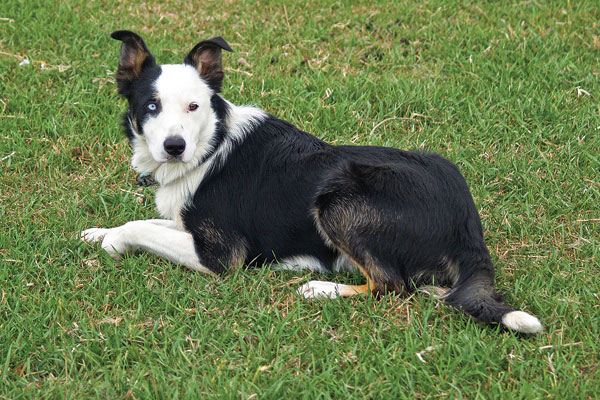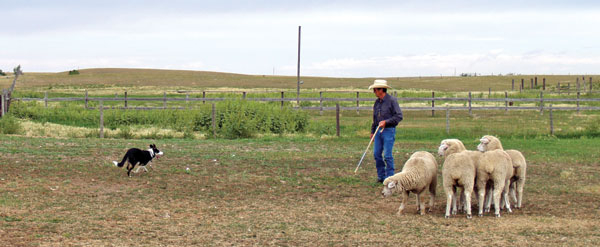Part Six: Whistles & Commands

Probably the most common question people ask me is, “How long does it take to train a dog?”
Well, that depends on a few things. Who is doing the training? How much time is going into the training, and how often or consistent are the training sessions? Also, all dogs learn at a different rate. Just like kids, some will learn and pick things up quicker than others.
It takes probably six months to a year of fairly regular training to get a dog to what I call fully trained. But, in one or two months, it can be fairly well started; started to the point where it can be used and be a lot of help around home. As you are using your young started dog to do simple jobs, he will keep getting better and more reliable as long as you do the things necessary to keep him under control and responding to you.
Most dogs come to me for 30 days of training. In that month there really aren’t that many total hours put into the dog. If you work a young dog about 15 minutes a training session, which is plenty long enough, and work it, say, four times a week, that’s only an hour a week. Four weeks in a month makes only four hours a month.
That might sound unreal but it’s really not. But keep in mind; I’m talking about getting results from an experienced and knowledgeable trainer. (Some people have years of experience, but really aren’t that
knowledgeable.)
Teaching Commands
With five basic commands a trained dog can be put in any position you want him. The standard universal commands are:
“Lie Down” – for the dog to stop “Away To Me” – for the dog to move to his right (counter-clockwise)
“Come By” – for the dog to move to his left (clockwise)
“That’ll Do” or “Come Here” – for the dog to come to you
“Get Up” or “Walk Up” – for the dog to advance toward the stock
Although these are the basic commands, there are many more that can, and will, be used as the dog gets fully trained. Commands for smaller flanking movements, for widening out, for running closer, for singling out an individual animal and for looking back for more stock behind a hill or in the bush. Also, there might be a “Stand on His Feet” command, or “Steady” or “Take Time” and even a “Bite” or “Don’t Bite” command.
Flanking commands (moving right or left when you ask him) can take a while to learn. Some dogs learn these quickly and some take a long time. It can be compared to kids learning to talk. Some are quicker than others — but most will learn eventually.
As you walk around with the dog balancing the stock to you, and when you change direction, give the appropriate command to suit the direction the dog is going. Eventually he will associate a particular direction with that command and, in time, go the proper direction because of the command given.
Side Commands

Dale has Gus circling counter-clockwise, or “Away to Me.” Dale has aimed his body at Gus’ hip similar to longeing a horse) to keep the dog moving forward, trying to get to the point of balance. Photo by Terri Mason.
You can start teaching side commands from the start of training when you are working on, and perfecting, his balance. As you have the dog circling the stock trying to get to the balance point or 12 o’clock, step in between the stock and the dog. Say the dog is going counter-clockwise or “Away To Me” in a fairly wide circle. You walk in a small circle around and close to the stock. Your body position, very much like it would be if you were longeing a horse, would keep the dog going. Then give the dog a “Come By” command and take a quick step or two and turn the dog back in the clockwise direction. This exercise also insures that the dog can be made to flank squarely as he turns.
When the dog is simply going to the balance point, the side commands won’t mean a lot to him. It’s not you flank him off balance, say from 1 o’clock to 3 o’clock or an inside flank, say from 4 o’clock to 7 o’clock, that the side commands start to make him think about the direction he is going.
When you start putting side commands on your dog, it is very important that you can stop your dog anywhere and call him to you. If, for instance, you are at 6 o’clock, the dog is at 3 o’clock and you ask him to flank to his left, or “Come By,” the dog’s instinct will tell him to go to his right or the point of balance. If he moves to his right, stop him with “Lie Down”, call him to you and as he comes toward you, give another “Come By” or “Come By Here”.
If the dog is at 9 o’clock and you want to flank him towards you, say “Come Here,” or “Away To Me” or “Away To Me Here.”
Before long, they will respond to the command without having to say “Come Here.” Once they begin to pick this up, they advance quite quickly.
Whistle Commands

The same thing applies to teaching whistle commands. People are often amazed when they see a dog working solely on whistles. Actually putting whistle commands on a dog is the easiest part of dog training.
The hardest part is learning how to blow the whistle.
If you can whistle through your teeth or with your fingers — great. If you can’t, there is a flat, half-moon whistle called a Shepherds Whistle that you hold in your teeth. With practise, you can make various notes and pitches and can certainly save the voice when working the dog at a few hundred yards or in a wind. Dogs learn whistle commands very quickly. Simply give the whistle command, followed by the voice command. If worked regularly a dog can be pretty solid on whistles within a couple of weeks.
Generally, the “Stop” whistle is a long, loud blast. A “Steady” whistle can be a shorter, sharper note. The “Walk Up” whistle can be a two-toned whistle that resembles the sound of the words “walk up.”
The side commands should be distinctly different. To the right could be two notes, from a low tone to a high tone, and to the left it can be reversed from a high tone to a low tone. The important thing is to practise blowing the whistle till you can make clear and consistent sounds. It’s not that hard. At one time, I had seven dogs each on a different set of whistles. They all had the same “Stop” whistle, but all the side commands and “Walk Up” whistles were different.
Training a dog is not that difficult if you understand their instincts and have done the proper ‘ground work’ or early obedience training. It can be very enjoyable when you see it improving, or frustrating when things are going bad. It is a near certainty that problems will occur somewhere in every dog’s training before he is ‘finished.’ When this happens, keep your cool and make sure the dog understands what he is getting corrected for. When a problem arises in a certain area of the advanced training, it may be because he doesn’t thoroughly understand a certain area of its early training. Never be afraid to back track and review earlier lessons. There is a saying; “Sometimes you must take one step back to get two steps ahead.” Nowhere does it apply more than to stock dog training.
Watch for a Bonus article next issue on “Troubleshooting”!
Dale has received a number of inquiries regarding specific problems people have with their dog. He helped them, and we realized that these brave souls might just be the tip of the iceberg, so we’ve talked Dale into writing one more article in the next issue — and it’s all about troubleshooting. You’re welcome! —Terri Mason, Editor














